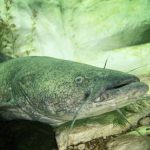Questions remain concerning fish populations in the Dan River following a coal ash spill that began Feb. 2, 2014 near Eden, North Carolina.
A break in a stormwater pipe beneath an ash basin at the retired Dan River Steam Station in Eden caused a release of ash basin water and ash into the Dan River.
Initial estimates from Duke Energy were that 50,000 to 82,000 tons of ash and 24 and 27 million gallons of basin water was released to the river as a result of the break in the stormwater pipe at the power plant.
The North Carolina Department of Environment and Natural Resources (DENR) began monitoring the spill on Feb. 3 after Duke Energy alerted the agency to the event.
Early testing by DENR near the coal ash spill found iron and aluminum levels to be at or above surface water quality standards.
Some initial water quality samples taken downstream of the spill site indicated exceedences of state surface water standards for arsenic, iron, aluminum, and copper. However, subsequent tests taken at the same sites have shown that neither arsenic nor copper exceed surface water standards.
Iron and aluminum have been high in historic water quality sampling conducted prior to the coal ash spill and are naturally occurring in soils in North Carolina.
In addition to testing water quality in the Dan River, DENR also began collecting and testing sediments and fish tissues to determine whether fish are safe to eat. Meanwhile, state public health officials advised people not to eat fish.
According to the Virginia Department of Health (VDH), coal ash may contain aluminum, antimony, arsenic, barium, beryllium, cadmium, chromium, cobalt, copper, iron, lead, lithium, magnesium, manganese, mercury, molybdenum, nickel, selenium, silver, strontium, thallium, tin, titanium, vanadium, and zinc.
The Virginia Department of Health (VDH) has an existing fish consumption advisory in place for the Dan River due to PCBs and mercury from historical activities not related to the recent coal ash spill. Do not eat flathead catfish greater than 32 inches, and do not consume more than two fish meals per month for several other fish species.
A team that includes staff from DENR, the EPA, the U.S. Fish and Wildlife Service and Duke Energy, is developing a long-range plan to recover large deposits of coal ash in the Dan River. Initial cleanup efforts have included the removal of coal ash near the outfall where the spill occurred.
After passing through Eden, North Carolina, the Dan River flows through the city of Danville Virginia, back into North Carolina, then flows back into Virginia, eventually emptying into the John H. Kerr Reservoir (Buggs Island Lake).
The Dan River is known for its diverse fish populations. The Upper Dan River includes areas that are classified as wild trout waters by the Virginia Department of Game and Inland Fisheries. In addition to native brook trout, the upper Dan contains non-native rainbow and brown trout.
Near Danville, the river contains largemouth bass, and catfish. The lower Dan River receives seasonal fish migrations from Kerr Reservoir. This section of the river is visited by walleye, striped bass, white bass, blue catfish, and flathead catfish.
One of crown jewels of the river is the Roanoke hogsucker, a species that is found only in the Dan River basin. Similar in appearance to the Northern hogsucker, the Roanoke hogsucker uses its unique mouth and body shape to hug rocks in the bottom of the river.
The Dan River system also contains two federally listed endangered species, the Roanoke logperch (Percina rex) and the James spinymussel (Pleurobema collina).
Additional Information
U.S. Environmental Protection Agency
North Carolina Department of Environment and Natural Resources
VA Department of Environmental Quality (VADEQ)
North Carolina DENR Dan River water quality sampling results
